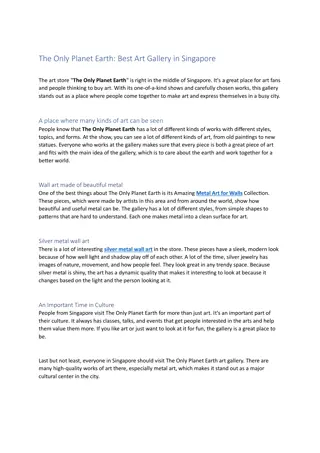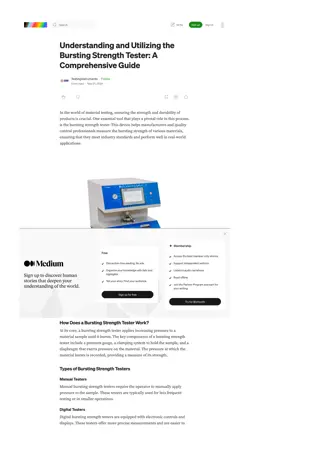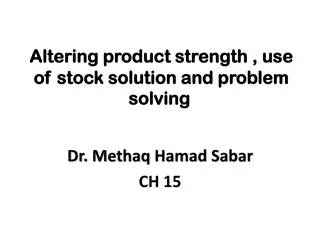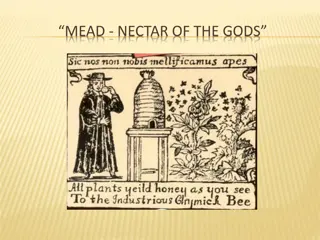The Art of Making Mead: A Guide to Types, Sweetness, Strength, and More
Mead, the ancient alcoholic beverage made from honey and water, has evolved into various types like traditional, fruit meads, spiced meads, and more. Understanding sweetness levels, alcohol content, and carbonation styles are key to mastering the art of making and enjoying mead.
Download Presentation

Please find below an Image/Link to download the presentation.
The content on the website is provided AS IS for your information and personal use only. It may not be sold, licensed, or shared on other websites without obtaining consent from the author.If you encounter any issues during the download, it is possible that the publisher has removed the file from their server.
You are allowed to download the files provided on this website for personal or commercial use, subject to the condition that they are used lawfully. All files are the property of their respective owners.
The content on the website is provided AS IS for your information and personal use only. It may not be sold, licensed, or shared on other websites without obtaining consent from the author.
E N D
Presentation Transcript
Mead And the art of making it. Ben Harmer, Canberra Brewers
What is Mead? Mead in its simplest form is just honey and water that has been exposed to yeast and has fermented to create alcohol. Mead is believed to be the oldest alcoholic beverage in existence and is theorised to have been discovered accidentally when a honey from a hive had mixed with water in a log and ancient hunters drank the liquid and discovered the magical effects of their first taste of alcohol. Today with the advancement of science we know its not a gift from the gods and how to control the process to ferment honey to make this wonderful beverage.
Types of Mead Traditional Honey & Water Dry Mead Semi-Sweet Mead - Sweet Mead SG: 1.035 1.080 FG: 0.990 1.010 ABV: 3.5 7.5% SG: 1.080 1.120 FG: 1.010 1.025 ABV: 7.5 14% SG: 1.120 1.170 FG: 1.025 1.050 ABV: 14.0 18.0% Fruit meads (Melomel) Melomel: This is a mead fermented with fruit. Pyment: This mead is fermented from honey and grape juice. Cyser: Pronounced size-er, this is produced from honey and apple juice. Morat: Mead from honey and mulberries. Capsicumel: Mead fermented from honey and chili peppers.
Types of Mead Then there are spiced meads (Metheglin) Metheglin s are Meads made from honey and a combination of spices, added either during or post fermentation. Rhodomel: Mead fermented from honey and rose petals. Braggot: Meads fermented with malted grains in addition to the honey. Other Mead types: Bochet: This is a mead fermented from caramelized honey. Acerglyn: This mead is from a combination of honey and maple syrup.
Sweetness A Mead may be dry, semi-sweet, or sweet as previously shown Sweetness simply refers to the amount of residual sugar in the Mead. Sweetness is often confused with fruitiness in a dry Mead. Body is related to sweetness, but dry Meads can still have some body. Dry Meads do not have to be bone dry. Sweet Meads should not be cloyingly sweet, and should not have a raw, unfermented honey character. Sweetness is independent of strength.
Strength (ABV%) A Mead may be categorized as hydromel, standard, or sack strength. Hydromel (or session): This is a low alcohol mead, often served carbonated similar to beer. It will have a final alcohol by volume (ABV) level of 3.5 7.5%. Standard Mead: This is a mead of table wine strength, that is, 7.5 14% ABV. Sack Mead: This is a mead of high alcohol content, greater than 14% ABV.
Carbonation A mead may be still, petillant, or sparkling. Still meads do not have to be totally flat; they can have some very light bubbles. Petillant meads are "lightly sparkling" and can have a moderate, noticeable amount of carbonation. Sparkling meads are not gushing, but may have a character ranging from mouth-filling to an impression akin to Champagne.
Making Mead There are numerous guides on how to make mead on the internet. I will refer to the way I have learnt to make mead and have achieved success. Although I ve been brewing for over a decade, my first batch of Mead wasn t until 2015. Using this method I came second in the Mead category at the Australian National Homebrew Championships (ANHC) in 2016 with my first ever batch of Mead using this method. Mead is often thought to take upwards of 12 months to ferment and become drinkable. This may have been the case in early brewing days however advances in knowledge, equipment and availability of ingredients, means you can now be drinking Mead within 3 months.
What do I need? Ingredients: Honey Water Yeast Yeast nutrient Fruits (Melomel) Spices (Metheglin) Equipment: Large Pot Fermenter Hydrometer thermometer Spoon Bottles (wine or Beer) Caps / Corks Syphon Heat source
What type of Mead? You first decision is what type of Mead are you going to make The style: Traditional, Melomel, Metheglin? Type of Honey? The more delicate varieties work better for traditional Meads were you can taste the flavor where stronger flavours can work better in Melomel s and Metheglin s. What strength and sweetness do you want to make. This will determine how much honey and the type of yeast you use. For easy batch creation use MeadMakr s batch builder https://www.meadmakr.com/batch-buildr/
Variety Honey You can make Mead with any variety of honey, however! As a general rule, the eucalypt varieties of honey aren t the best for making Mead. The eucalypt can be a dominant flavour, and can also take much longer to mellow with age. The best honey varieties are non eucalypt varieties such as fruit, floral or clover/meadowy honeys. Cappings are great for making Mead as you can rinse the honey from the wax cappings and use the liquid to make Mead!
Yeast Yeast selection is important in making mead as it will determine the finishing character your Mead will have. Recommend using a neutral, alcohol tolerant 10%ABV+ yeast. Wine and champagne yeasts are popular however a dry neutral beer yeast will also work. Examples of popular mead yeasts are Lavlin 71B or EC1118 , Fermentis US05 or White Labs WLP720. Mead needs a lot of yeast, double or triple what beer does. For a standard mead 7-10% use at least two packets or make a starter. For best results use the tools on https://www.meadmakr.com/
Yeast health Yeast health is the most common reason why Meads are known to take so long to ferment. They key to a quick and healthy fermentation is ensuring that the yeast has all the nutrients it needs during its fermentation life cycle. Elements required for yeast health: Sufficient Yeast cells (enough yeast packets to enable the yeast to comfortably ferment the volume of liquid) Yeast nutrient Specialised combination of nitrogen and minerals to allow for yeast cell growth and reproduction. Oxygen sufficient Oxygen in solution for yeast cell growth and reproduction. Temperature control. Keeping the yeast within the desired temperature to ensure a clean fermentation and yeast health.
Yeast Nutrient There are several types of nutrients recommended for Mead fermentation: DAP (Diammonium Phosphate) Ok Common brewer yeast nutrient Good Go-Ferm Yeast growth / Starter booster (pre-ferment) Great Fermaid K non organic nitrogen Great (issues getting in Aus) Fermaid O Organic Nitrogen Best https://www.meadmakr.com/advanced-sna-calculator/
Process Boil your required water to ensure the Chlorine is removed. Let some of the water cool separately. Dilute the honey with some of the water required and sterilise the solution by boiling briefly or pasteurising. Boil or not to boil Recommend a quick boil of about 10 mins. Ensure any wild yeast and bacteria is killed off. Otherwise a pasteurisation of at least 72 degrees for about 30 minutes. Use remaining chilled water to dilute the batch to the desired gravity or volume trying to hit a temperature as close to 18 degrees. Agitate or use an oxygen stone to get oxygen into the solution. Pitch the yeast and nutrient and leave in a temperature controlled environment. Add additional nutrient each day for about 7 days as directed. Check gravity periodically with hydrometer to check fermentation. Once within range for FG. Bottle and age for 1 month to 25 years!
About the Canberra Brewers www.canberrabrewers.com.au Meet the first Wednesday of everyone month (except Jan and Oct) at 7:30pm Gorman House, City. Our mission is to improve the quality of home brewing in the local community through education. We hold 2 competitions a year in which we will judge Mead and provide feedback to the entrant. The ACT competition is the qualifier for the national competition where the top 3 entrants progress to be judged at the Australian Amateur Brewing Championships (AABC). Mead Style Guidelines are available from the BJCP website https://www.bjcp.org/docs/2015_Guidelines_Mead.pdf
References 1. We need to talk mead Presentation by Michael Fairbrother ANHC 2014, Canberra ACT. 2. https://www.meadmakr.com/ 3. http://beersmith.com/blog/2013/09/20/making-mead-for-home- brewers/ 4. http://www.skyriverbrewing.com/Mead/mead-history.html 5. https://www.bjcp.org/docs/2015_Guidelines_Mead.pdf 6. http://www.meadmaderight.com/























